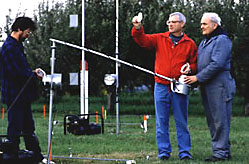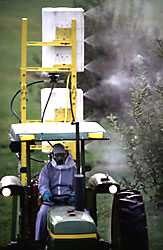Gentle Sprayer Cuts Pesticide Drift
Gone-with-the-wind spray drift from pesticide applicators may blow across neighboring fields and residential areas, raising concerns about the environment. It's an old problem that an ARS-university team hopes to help solve with new sprayer technology.
ARS engineers Robert D. Fox and Ross D. Brazee have helped fine-tune a pesticide sprayer that uses multiple fans to disperse the chemical. This helps reduce spray drift and improves accuracy of pesticide deposition. The crossflow fans provide a smoother, gentler flow of air. Tests show the crossflow fan applicator could halve airborne spray drift under specific conditions.
“Our overall mission is finding ways to apply compounds like pesticides more efficiently with regard to their impact on the environment,” says Brazee, who heads the ARS Application Technology Research Unit at Wooster, Ohio. "You can have all the effective agents in the world, but there's still the challenge of getting them on target."
The research team compared a prototype of the crossflow fan sprayer with conventional sprayers used in most commercial orchards and nurseries.
Joining Brazee and Fox in the work were scientists from Ohio State University's Agricultural Research and Development Center and Sven A. Svensson of the Swedish University of Agricultural Sciences.
Orchard managers growing apples, pears, cherries, plums, peaches, and other tree fruits face a perennial challenge in controlling fruit-eating insects, fungal blights, and diseases that cause millions of dollars' worth of crop losses each year.
Increasing concerns over the impact of pesticides on the environment—especially in residential areas—are behind the push to develop more effective ways to use pesticides without diminishing their effectiveness or driving up agricultural producers' costs.
Advances in mechanical technology and the introduction of more compact dwarf or semidwarf hybrid fruit trees have changed the way orchard managers approach pesticide application.
"Dwarf fruit trees are smaller and more dense than their ancestors," Brazee notes. "We have to adjust our procedures and machines to match this change."
The conventional orchard air sprayer is generally tractor-drawn and includes a cylindrical tank and large fan to spray the chemical. Air drawn into the back of the sprayer directs the flow of spray outward and upward and creates a large, nearly 180-degree, fan-shaped airjet.
While generally effective in depositing spray on and inside the fruit trees’ leaf canopy, conventional units tend to create more spray drift—tiny droplets of pesticide—that can be caught and carried by the wind. These units also frequently deposit more chemicals on the lower part of the tree, resulting in less effective use of the pesticides."
 Electronic technician Barry Nudd (left) and agricultural engineers Ross Brazee (right) and Robert Fox inspect a collection filter from a high-volume air sampler. (K7603-2) |
The ARS engineers and their cooperators conducted experiments to sample downwind residues from use of conventional sprayers at a semidwarf apple orchard at Wooster. They found spray drift was greatest from applications to the last one or two rows on the downwind edge of the orchard. “That’s because there are no other tree rows to block it,” Brazee says.
Other weather factors including humidity, temperature, windspeed, and wind direction can also have a profound effect on the likelihood of spray drift.
Cooperator Svensson brought to this country two crossflow fan units that have been available in Europe for the past decade and more recently in the United States. Use of two or more fans allows spray to be more uniformly distributed over fruit trees.
The resulting sprayer unit is taller than its conventional cousin. Svensson found that tipping the upper fan downward improved deposition of pesticides on the far side of the fruit trees, compared with spraying with both fans aimed horizontally.
This not only gave good chemical penetration into the tree canopy, but also reduced spray drift into the atmosphere.
"We measured deposits left by the crossflow fan and compared them with those left by the conventional fan sprayer,” says Fox. “We found the crossflow fan’s downwind deposits above tree height were much less than those from conventional sprayers.”
At heights around 11.5 to 14.5 feet—about 3.25 feet above the top of the tree canopy—crossflow deposits were at least 40 percent less than conventional sprayer deposits.
The engineers also found the spray drift from the crossflow fan didn't travel as far downwind as spray did when applied with the conventional sprayer. "As we went downwind 195 to 390 feet, we found we had only about half the amount of material being deposited when we used the crossflow fan," Fox says.
"The downward momentum of the crossflow fan sprayer limits drift because it limits the amount of spray becoming airborne," adds Brazee. "One problem we have witnessed with conventional sprayers is that the spray cloud dodges, or goes around the tree canopy. Some spray actually goes up and over the trees. The cross-flow design helps limit this effect."
While changes in technology will ultimately help orchard and nursery managers achieve good pest control with less impact on the environment, producers must also rethink how they manage their orchards and nurseries with several factors in mind, Fox says.
"For instance, there are things they can do to minimize spray drift simply by spraying those last two rows from the outside in, rather than the inside out," he says.
The introduction of smaller, tighter, high-yield fruit trees has also required orchard managers to pay more attention to integrated pest management (IPM) and use of pesticides overall, Brazee observes.
“Today’s fruit trees are less labor intensive than their ancestors, but they require more management. It’s a trade-off for growers. One of our goals is to make their job easier by providing better technologies—with less impact on the environment—without driving up their costs,” he says.
Both researchers acknowledge that weather is the greatest variable in orchard and nursery management today. “We are still conducting experiments and trying to get the data we need to help growers make decisions for the most common conditions they must face,” says Fox.
While the air-curtain or crossflow fan sprayer is commercially available to growers, ARS researchers are keenly aware of the cost of replacing trees and equipment. "We will continue research on the crossflow fan," says Fox. "We're always looking for the next weather variable to test our theories." -- By Dawn Lyons-Johnson, ARS.
Ross D. Brazee and Robert D. Fox are in the USDA-ARS Application Technology Research Unit, Ohio Agricultural Research and Development Center, Wooster, OH; phone (330) 263-3870.







